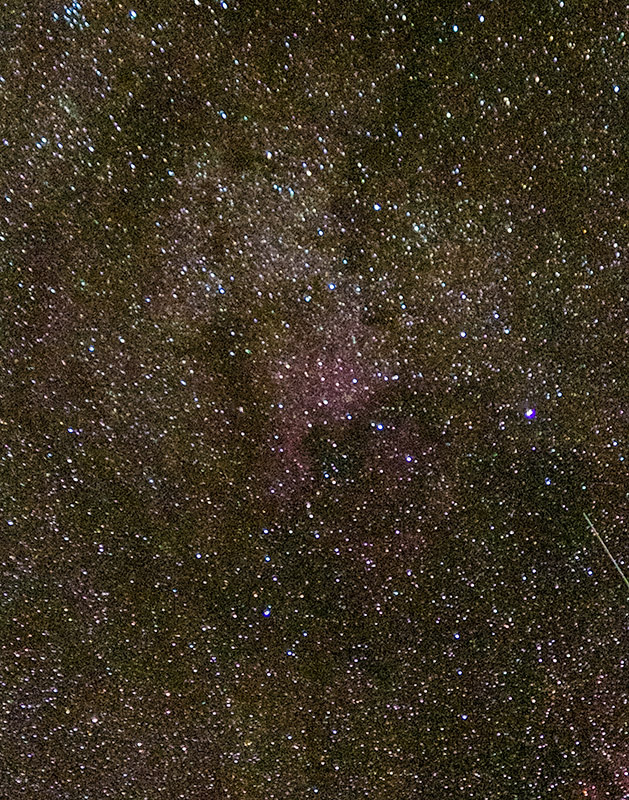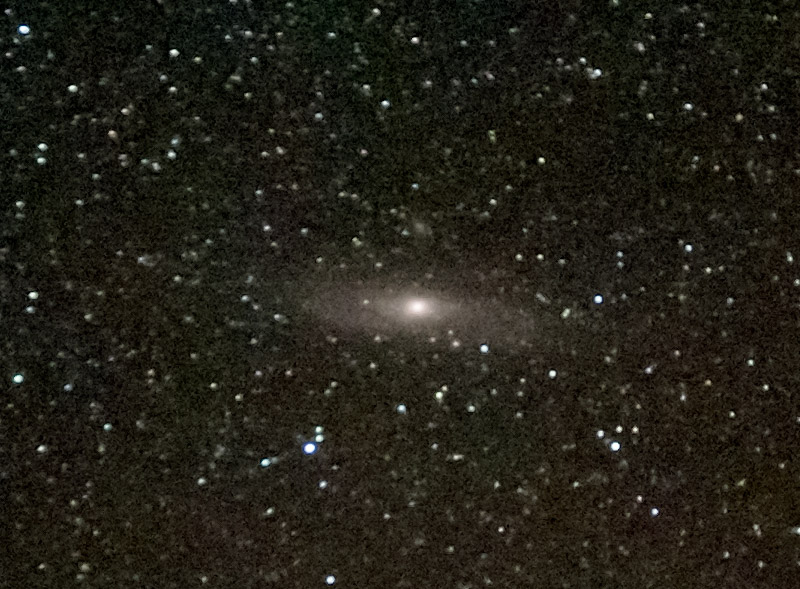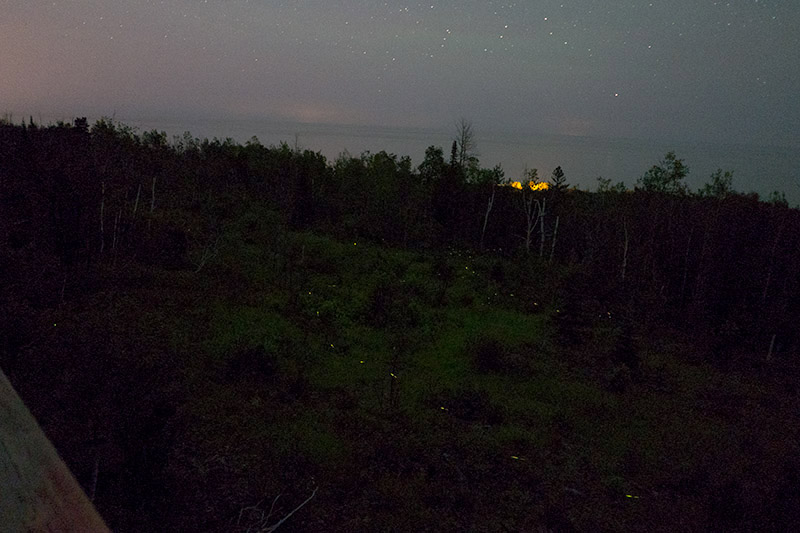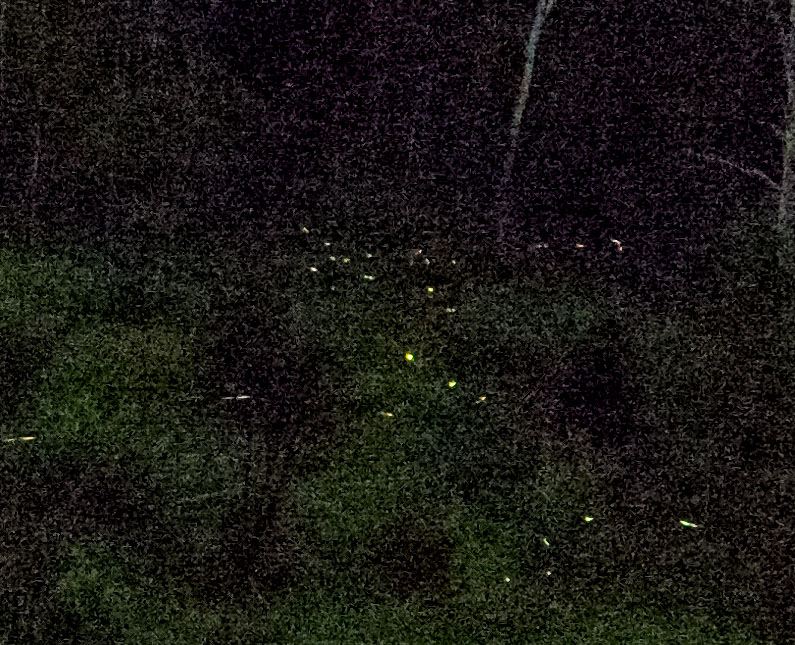By Ctein
Last week I wrote about my dislike for the Fuji X-Pro1, but that's not to say it's an objectively-bad camera. My personal take on the image quality is that it gets a solid B or B+. I grade on an absolute scale, not relative to other cameras in the same size/price range, so this is fair praise. In particular, its low light performance seems pretty good.
The Fuji is probably not better than other cameras of the current generation, but that's a big improvement over my four-year old Olympus. What this really speaks to is the overall state of digital photography today. To put it technically, Fuji's low light abilities are effin' unbelievable.
Here's the setup:
One of the best things I did on my Minneapolis vacation was I got to spend three days with my friend Rachel at her folk's cabin on the North Shore (of Lake Superior) so we could get in some stargazing.
"Stargazing" is a euphemism.
For astronomy.
We're both avid amateur astronomers, and whenever I visit Minneapolis the two of us try to get in some observing time together. She's got lots easier access to dark(er) skies than I do, so I see lots of stuff with her that I don't get to see at home, even though I've got a 10" scope and she has a six.
Up on the North Shore, it gets really dark. To the south of the cabin is the vast, wet, and unpopulated expanse of Lake Superior. The only sources of light pollution are Duluth, which is a good 100 miles to the west, and, eastward, the teeming metropolis of Grand Marais (pop: 1,300). We lucked into two nights of mostly clear skies (and mostly moon-free, it should go without saying). Two out of three is not bad.
Aside from looking at a whole bunch of old favorites, I got to see several objects I'd never been able to observe before, because of too-bright skies, including the great spiral galaxy, M101, and a very nearby dwarf galaxy that was an NGC object, my first ever NGC galaxy [NGC = John Dreyer's New General Catalogue of Nebulae and Clusters of Stars, a well-known catalogue of deep sky objects —Ed.]. The sky was so dark, in fact, that the two of us observed that the North America nebula was just barely a naked eye object! A surprise discovery for both of us.
Simple astrophotography
I like playing
around with astrophotography. The simple kind, where you just set the
camera up on a tripod, open the shutter for a while, and see what gets
recorded. I'd done some of that with my Olympus Pen and was always
amazed at what a few seconds of exposure could capture. The Fuji blew
way beyond that previous amazement.
 Fig. 1. North America Nebula. 5 sec. @ ƒ/1.4, ISO 1600, 35mm lens (50mm equiv.). This is a 50%-scale crop from the full frame.
Fig. 1. North America Nebula. 5 sec. @ ƒ/1.4, ISO 1600, 35mm lens (50mm equiv.). This is a 50%-scale crop from the full frame.
The aforementioned North America nebula took a mere 5 second exposure at ISO 1600 (figure 1). This is a 50%-scale crop from the full frame that clearly shows the nebula's reddish color as well as the signature "Gulf of Mexico." By astrophoto standards, nothing to write home about. But, for a normal camera with a normal lens, just plopped on a tripod, it's impressive.
 Fig.
2. M31, the Andromeda Galaxy, along with its satellites, M32 and M110. 5
sec @ ƒ/1.4, ISO 4000, 35mm lens (50mm equiv.). This is a 100%-size
crop from the full frame.
Fig.
2. M31, the Andromeda Galaxy, along with its satellites, M32 and M110. 5
sec @ ƒ/1.4, ISO 4000, 35mm lens (50mm equiv.). This is a 100%-size
crop from the full frame.
For true mind-blowing performance, though, check out this photo of the Andromeda Galaxy (M31) along with its two satellites (figure 2). Now we're cranked up to ISO 4000, and this 100% crop faintly shows the dust lanes in the spiral arms. True, they're right down at the level of system noise, but they persist from frame to frame, so I know they're real and not artifact.
Photographing Andromeda isn't hard; it's bright and big. Getting detail in it with an ordinary camera is another matter. Wish I'd had a third clear night so I could've tried this with a longer lens.
I'm not quite done.
The trip had an added bonus for me: there were fireflies up there. Fireflies! I was in heaven. Those are one of my few fond childhood memories and I hadn't seen any in decades (they don't exist where I live). After I jumped up and down and burbled and cried a little bit, I went for the camera (figure 3). Sorry for the unlevel horizon line—I couldn't see what I was pointing at! The only source of illumination in this photograph is starlight and airglow. (Rachel and I don't know if the faint pink and green bands in the color are a very dim auroral display or due to very thin high clouds. They were below human visibility. They're not camera artifacts.). This isn't dusk, it's 1:00 in the morning. Stars in the sky, fireflies in the trees. What could be better?
 Fig. 3. Fireflies by starlight! Can you believe it? 30 sec @ ƒ/2, ISO 6400, 18mm lens (28mm equiv.).
Fig. 3. Fireflies by starlight! Can you believe it? 30 sec @ ƒ/2, ISO 6400, 18mm lens (28mm equiv.).
I never in my wildest dreams imagined I'd ever be making photographs by starlight with a normal camera. And, remember, the Fuji is far from the best low-light camera on the market today.
 Lots of fireflies—same photo as Fig. 3, but here's a 100% crop instead of the full frame.
Lots of fireflies—same photo as Fig. 3, but here's a 100% crop instead of the full frame.
As I said—putting it technically—it's effin' unbelievable.
And, let's not forget, we're still a couple of stops away from theoretical limits of performance (see "Photography at the Speed of Light" and "Something Old Something New"). Things will only get more unbelievable.
Ctein
Ctein's weekly column rises above the level of system noise on Wednesdays.

My most prized book is Crewdson's Fireflies. Fireflies are just wonderful, amazing creatures to behold.
Posted by: Paddy C | Wednesday, 18 July 2012 at 01:18 PM
The St. Croix River is the border between a long stretch of Minnesota and Wisconsin, and is rich in fireflies. I used to live on the St. Croix, I loved watching them on warm summer nights -- they used to be considered to be the companions of fairies, and when you watch them, you can see why. Because I come from the bad old days of film and color ISOs of less than 100, it never occurred to me to try to photograph them, even after I acquired a D3. I suspect a photographic masterpiece lurks out there with the fireflies.
As I become more familiar with Ctein's photography, I suspect he needs a D4. A great many of his portfolio photos seem to be handheld at night, and even a Fuji is a handicap there, compared to other possibilities.
Posted by: John Camp | Wednesday, 18 July 2012 at 01:45 PM
Cool pictures. We live on a farm that is far enough out of town that the place can get darker than the inside of a cow. I have occasionally taken a camera out for shots of the night sky off a tripod. They are generally OK but not Sky and Telescope worthy by a long shot.
A few years back my family bought me a simple telescope for my birthday (6" newt with an unmotorized GEM). I suppose buying a motor and learning how to polar align the thing would open up the possibility of some piggyback photography.
I should put it on the "to do" list which of course means "nice idea, not gonna happen".
The fireflys are very cool.
Posted by: Mike Plews | Wednesday, 18 July 2012 at 02:42 PM
We called them lightning bugs during my youth in Maryland. They often appeared about the time the Honeysuckle would be in bloom, allowing us to suck the nectar from the plucked stems. Great summer night memories.
My best star gazing was when I later lived outside Santa Fe, at 7000 feet, and away from all the city lights. Stars seemingly touching the earth in all directions. No lightning bugs there, but sometimes reflections from the eyes of curious coyotes.
Posted by: Jeff | Wednesday, 18 July 2012 at 03:30 PM
Digital cameras have really come a long way. This shot of M31 is with and ordinary camera and ordinary lens: 5D2 with 70-200mm F/4 IS @ f/4, ISO 800.(OK, both are nice, but they are off-the-shelf). Four, five, and six minute exposures stacked.
http://www.flickr.com/photos/agavephoto/5149657253/in/set-72157625020437495/lightbox/
This is, of course, using an equatorial mount to eliminate star trails during longer exposure times.
Posted by: Drew Medlin | Wednesday, 18 July 2012 at 03:33 PM
I took an 'astrophotography-like' photo once on accident. Camping, late at night after some drinks, I set my camera down on a log or a bench (no tripod) and blindly fumbled for maximum exposure and infinity focus. I was trying to capture some shenanigans in the lake.
A minute or so later, I saw the freakin milky way appear on my LCD screen. My eyes snapped up to the sky to double check. Yup, its there all right, although I hadn't noticed it before it appeared in my over exposed accidental photo.
Posted by: ILTim | Wednesday, 18 July 2012 at 03:36 PM
6 a.m. here in Australia... just got in from shooting the alignment of Pleiades, Venus, Jupiter, Orion over Hanging Rock, Victoria in the Eastern sky. (Incidentally, "Stellarium" is by far the best software I've discovered for astronomical predictions... anyone know any better?) .Have been waiting for a clear sky- I missed the shot last Friday with the waning Moon near Jupiter- it would have been a beaut.. been drizzling rain, now freezing..very happy with the low light performance of my new Oly EP-3, am now waiting for my tax refund to get the OM-D and 12mm f2. I borrowed one last weekend to confirm what I've known/suspected since it was released.. mind blowingly good at high ISOs-- only complaint is battery drain/ lack of battery supply. Absolutely brilliant camera otherwise. About to jump ship from Canon. Only other problem is that when I'll use it at a wedding, I wonder what the impression will be when I'm not using Canikon? I know there'll be MUCH less post production, since in 80-90% of the shots, the JPEGs will be totally usable, instead of perhaps 40% with Canon,-- much less RAW conversion needed. We got the first shipment of 75mm f1.8s in last week... just plain WOW!!!! Never seen anything like it. I must try the 17mm fO.95 Voigtlander one night. I'm very disappointed at the coma on my old 50mm f1.4 Zuiko from OM days on my EP-3 with adapter.. wide open it's almost unusable. Oh, well, the 12mm is going to be fun. Must away and shoot the frosty sunrise.
Posted by: Bruce | Wednesday, 18 July 2012 at 04:13 PM
Hi Ctein,
That's amazing!
Were these taken with dark frame noise subtraction? Does the XPro1 even have that option?
Posted by: robert e | Wednesday, 18 July 2012 at 04:35 PM
wonderful! i still remember seeing fireflies when i was 3 years old.
this is one of the reasons i want a full frame camera with image stabilized primes. new possibilities.
Posted by: raizans | Wednesday, 18 July 2012 at 04:55 PM
It's not just the frames that are remarkable. I was framing a shot by hand of a city building at night (OM-D with 45mm) and saw in the VIEWFINDER a strange moving white point. Moth or nighthawk, maybe, lit by a streetlight? No, a satellite that I couldn't even make out by eye until 30 seconds later. Cameras now double as night vision goggles....
Posted by: Mark Kirkpatrick | Wednesday, 18 July 2012 at 07:24 PM
Ahhh....fireflies....tough to photograph just one.
http://www.flickr.com/photos/johnmflores/4698441054/"
Posted by: JohnMFlores | Wednesday, 18 July 2012 at 07:26 PM
I grew up in Colorado, where there are no fireflies. (As I understand it, there may well be insects of the family Lampyridae, but they don't glow.) I now live in the DC suburbs and I see them every summer. My current house is on a hill backed up to a forest, and I've seen fireflies every night for two months. I never get tired of them.
For the most part, I feel like I'd be pretty much set with a camera that was clean at 1600 and usable for snapshots to 3200; these photos make me wish for a D4. Someday, after I win the Powerball...
Posted by: Nicholas Condon | Wednesday, 18 July 2012 at 07:58 PM
A while back, I mounted a 1970s Vivitar 300mm lens on my Olympus 4/3 DSLR, went outside and took a few shots of the moon. Sunny 16 plus fudge factor, handheld. The pictures were nicely sharp--thank you, In-Body Image Stabilization. But even better, I could actually see that the shadows inside large craters near the terminator had moved between exposures. Of course, why wouldn't they? But I could see this in pictures I took myself, using modest equipment that many people would sneer at. Like you say, bleeping amazing.
Posted by: Peter Klein | Wednesday, 18 July 2012 at 08:04 PM
Very cool. But if you're in Minnesota, you're not on the north shore. The north shore is in Ontario. True North. Just sayin'
Posted by: Earl Dunbar | Wednesday, 18 July 2012 at 08:51 PM
I'm still new to astronomy myself and been dabbling in beginners level astrophotography for a couple of years. Dealing with unwanted star trails is a challenge without expensive equipment. There are DIY hinge mounts you can try but there is a new product which is perfect for quick and easy long exposures called Vixen Polarie. It's basically a small box that mounts to a camera tripod, you align it with your celestial pole, attach your camera and it tracks properly. So it's a perfect companion to have in your camera bag for when the skies are clear and the stars beckon.
Posted by: steve | Wednesday, 18 July 2012 at 10:44 PM
Dear JC,
I suspect you're right about the fireflies. I doubt I'm the one to make that masterpiece, although sometimes I do surprise myself.
Most of my portfolio work that's done at night is done on a tripod, not handheld. There have been occasional, notable exceptions. They are not the norm.
That question of what camera I “need” is interesting and complicated one. A couple of years back, when Jim Marshall died, there was a prospect for moving my entire collection of his work in one sale. Had that happened, the windfall would have been large enough that I could have easily afforded to buy any digital camera I wanted. I mean, any-- up to and including the Leica S2. I hadn't been in that kind of a situation since my college days, when I invested myself in the Pentax 6x7.
So, I started thinking about what camera I really wanted, price not being the object. I was able to winnow it down to four or five… which had nothing in common with each other. The list included micro four thirds, the Pentax 645D, and one of the Canon/Nikon speed champions, among others.
What this told me was that I didn't actually know what I wanted. Each choice seemed absolutely ideal and orthogonal to the next.
“Fortunately” I was never forced to choose. At this point, with a couple more years of compact camera system experience behind me, I'm feeling like that's worth more to me than anything else. It's not that I can't haul around a ton of gear; I'm still fit and strong for my size. It's that after doing that for my entire career, it's such an interestingly different (and enjoyable!) experience not doing that.
That said, I have thought of one or two artistic projects that would demand ultra-high ISOs of high quality. On the other hand, I've thought of many artistic projects that wouldn't. The former does not have precedence over the latter. But it's food for thought, for me.
pax \ Ctein
[ Please excuse any word-salad. MacSpeech in training! ]
======================================
-- Ctein's Online Gallery http://ctein.com
-- Digital Restorations http://photo-repair.com
======================================
Posted by: ctein | Wednesday, 18 July 2012 at 11:54 PM
Dear ILTim,
I have a related amusing story. My first digital astrophotography happened several years back when I was in the Adirondacks with an especially dark sky and I got curious to see what my Fuji all-in-one could do when pointed heavenwards. I set it in the general direction of Cassiopeia and Andromeda just to see if it could pick up M31 with a few seconds exposure. And, astonishingly, even with that quarter-scale sensor, it did just fine. A little bitty fuzzy featureless blob, but definitely a fuzzy blob in contrast to the hard stellar images around. Cool.
Reviewing the scene, I discovered I'd picked up nebula or maybe a globular cluster near Cassiopeia. I didn't have any star charts with me, so I went online and started looking for diagrams of that sector of the sky, comparing it to the lists of Messier objects. Nothing matched up, but the online charts I was finding weren't all that good. Still, after half an hour, I hadn't been able to identify it as either a Messier or NGC object.
Finally it dawned on me, I had accidentally photographed Comet Holmes. I was confusing it with a Messier object.
Messier would've gotten a good laugh out of that one.
pax \ Ctein
[ Please excuse any word-salad. MacSpeech in training! ]
======================================
-- Ctein's Online Gallery http://ctein.com
-- Digital Restorations http://photo-repair.com
Posted by: ctein | Thursday, 19 July 2012 at 12:02 AM
Cool post, particularly the shot of M31.
I'm a city kid and I've never been in places where the sky's dark enough to do much stargazing. But I recently went on an expedition to Wyoming (dinosaur fossil dig) and one night I set up my camera on an flimsy Ultrapod to get a shot of the stars and was stunned when the image review came up after the 20s exposure.
https://fbcdn-sphotos-a.akamaihd.net/hphotos-ak-snc6/229966_10151051804081138_170481307_n.jpg
D3, 24-70 @ f/2.8, ISO 3200, 20s
Posted by: Darren | Thursday, 19 July 2012 at 02:30 AM
That's a nice shot Darren.
Mike
Posted by: Mike Johnston | Thursday, 19 July 2012 at 06:24 AM
Now all you need to do is get Fuji to produce a consumer-grade camera with built-in thermoelectric cooler for the sensor and the capacity to do _really_ long exposures. Even better, of course, would be a liquid nitrogen bath, but I'm guessing that would be very expensive.
Posted by: MacCruiskeen | Thursday, 19 July 2012 at 08:18 AM
Whatever it is it is the camera that you have that take photo. I would not recommend any GEM (got two in two homes to avoid travel with them but still not get used).
Recently got the astrotrec and still too big (but necessary if you try modified Canon).
I am still thinking about the POLARIE is temping and I struggle whether to get the K5+GPS to have the simplest setup. But just to take a few pics does not make sense.
A simple setup is nice
Posted by: Dennis Ng | Thursday, 19 July 2012 at 09:20 AM
I grew up in Silver Bay. I envy your North Shore experience.
Posted by: Gunny | Thursday, 19 July 2012 at 09:37 AM
Ctein,
Turns out that we do have at least some cousins of the firefly resident in the SF Bay area.
They don't fly, but they do glow.
I've observed them (very rarely) in the Santa Cruz mountains, above St. Helena in Napa county, and years ago in the San Bernardino mountains east of L.A (probably Microphotus angustus). Nothing like the displays I've seen on a couple of summer nights in Michigan and Minnesota, but still...
Posted by: steveH | Thursday, 19 July 2012 at 11:19 AM
Dear Nicholas,
There are a number of cameras that aren't astronomically (ahem) priced that produce clean ISO 1600 and usable 3200. The Olympus OMD, for example.
pax / Ctein
Posted by: ctein | Thursday, 19 July 2012 at 01:11 PM
Interestingly, the previous generation of 4/3rds CCD (the Kodak 8300 sensor) has been a popular platform for cooled astronomical cameras.
I've just started noodling with these things with an older camera (with a Sony sensor) and a ludicrously wonderful telescope mount. If you thought those RRS tripods and ballheads were nice, check out what Astro-Physics makes...
With a bit of work, you can do some incredible things
http://www.flickr.com/photos/79904144@N00/sets/72157630154101860/
Oh, and this is from my back yard, through the suburban skyglow.
Posted by: psu | Thursday, 19 July 2012 at 05:49 PM
ah, this is bad. Astrophotography is the one thing that makes me want a new digital camera...
Mike
Posted by: Mike Shimwell | Thursday, 19 July 2012 at 06:40 PM
Dear psu,
Those are exceedingly impressive for a suburban setting. What major metropolitan are you near to?
pax / Ctein
Posted by: ctein | Thursday, 19 July 2012 at 08:09 PM
An excellent article - perfect complement to the other about the X-Pro 1.
I read dpreview about it for the first time, the other day; I saw no articulating LCD panel and the cable release is mechanical only so can't be used for timelapse sequences, which together basically ruled it out for my purposes. But I certainly envied the low-light / high-ISO performance that you've demonstrated further here.
Posted by: Tim | Friday, 20 July 2012 at 09:00 AM
Thanks.
I'm about 10 miles north of Pittsburgh. The sky at my house to the North and East is decent, maybe down below 4th mag on the best nights, but that might be optimistic.
South and West is where Pittsburgh is.
The "secret", if there is any, for getting pictures in this setting is probably a combination of
1. Modern CCDs, which are exceedingly low noise.
2. Stacking many short exposures to reduce noise even more.
3. Some modern software techniques for mitigating gradients and other insults.
4. Light pollution filters when shooting into the worst of the muck.
5. Cheating by ignoring color, for now. Color is hard.
My stuff is pretty good, but I think there are other people doing more impressive work in similar settings. I'm not yet up to doing things like putting the camera on one object all night and things like that. :)
Posted by: psu | Saturday, 21 July 2012 at 01:59 PM